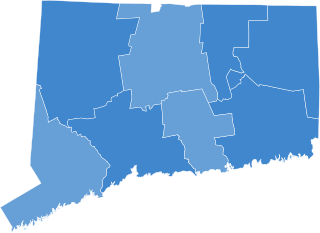
Elizur Goodrich was an eighteenth-century American lawyer and politician from Connecticut. He served as a United States representative from Connecticut and Collector of Customs. He was also the brother of US Senator Chauncey Goodrich, son-in-law of Founding Father Oliver Wolcott.

Gideon Tomlinson was a United States senator, United States Representative, and the 25th Governor for the state of Connecticut.

Oliver Wolcott Jr. was an American politician and judge. He was the second United States Secretary of the Treasury, a judge of the United States Circuit Court for the Second Circuit, and the 24th Governor of Connecticut. His adult life began with working in Connecticut, followed by participating in the U.S. federal government in the Department of Treasury, before returning to Connecticut, where he spent his life before his death. Throughout his time in politics, Wolcott's political views shifted from Federalist, to Toleration, and finally Jacksonian. Oliver Wolcott Jr. is the son to Oliver Wolcott Sr., part of the Griswold-Wolcott family.
The Toleration Party, also known as the Toleration-Republican Party and later the American Party or American Toleration and Reform Party, was a political party that dominated the political life of Connecticut from 1817 to 1827. The American name referred not to nativism or the later Know Nothing, which was also known as the American Party, but to the party's national orientation.

The 1831 Connecticut gubernatorial election was held on April 8, 1831. Incumbent acting governor and National Republican nominee John S. Peters was elected to a term in his own right after the resignation of his predecessor Gideon Tomlinson, defeating Anti-Masonic nominee Zalmon Storrs with 68.75% of the vote.

The 1830 Connecticut gubernatorial election was held on April 8, 1830. Incumbent governor and National Republican nominee Gideon Tomlinson ran essentially unopposed, winning with 96.19% of the vote amidst a scattering of votes.

The 1829 Connecticut gubernatorial election was held on April 9, 1829. Incumbent governor and National Republican nominee Gideon Tomlinson ran essentially unopposed, winning with 97.52% of the vote amidst a scattering of votes.

The 1828 Connecticut gubernatorial election was held on April 10, 1828. Incumbent governor and National Republican nominee Gideon Tomlinson ran essentially unopposed, winning with 97.73% of the vote amidst a scattering of votes.

The 1826 Connecticut gubernatorial election was held on April 13, 1826. Incumbent governor and Toleration Party candidate Oliver Wolcott Jr. defeated former senator and Federalist Party candidate David Daggett, winning with 56.77% of the vote.

The 1825 Connecticut gubernatorial election was held on April 14, 1825. Incumbent governor and Toleration Party candidate Oliver Wolcott Jr. defeated Federalist Party candidates former senator David Daggett, former delegate Nathan Smith and former congressman Timothy Pitkin, winning with 68.82% of the vote.

The 1824 Connecticut gubernatorial election was held on April 8, 1824. Incumbent governor and Toleration Party candidate Oliver Wolcott Jr. defeated former congressman and Federalist Party candidate Timothy Pitkin, winning with 88.81% of the vote.

The 1823 Connecticut gubernatorial election was held on April 10, 1823. Incumbent governor and Toleration Party candidate Oliver Wolcott Jr. won re-election with 88.96% of the vote.

The 1822 Connecticut gubernatorial election was held on April 11, 1822. Incumbent governor and Toleration Party candidate Oliver Wolcott Jr. defeated former congressman and Federalist Party candidate Zephaniah Swift, winning with 86.59% of the vote.

The 1821 Connecticut gubernatorial election was held on April 12, 1821. Incumbent governor and Toleration Party candidate Oliver Wolcott Jr. was re-elected, winning with 86.91% of the vote.

The 1820 Connecticut gubernatorial election was held on April 13, 1820. Incumbent governor and Democratic-Republican Party candidate Oliver Wolcott Jr. was re-elected, defeating Federalist Party candidates former delegate Nathan Smith and former congressman and state legislator Timothy Pitkin with 76.14% of the vote.

The 1819 Connecticut gubernatorial election was held on April 8, 1819. Incumbent governor and Democratic-Republican Party candidate Oliver Wolcott Jr. was re-elected, winning with 86.85% of the vote.

The 1818 Connecticut gubernatorial election was held on April 9, 1818. Incumbent governor and Toleration Party candidate Oliver Wolcott Jr. was re-elected, defeating congressman and Federalist Party candidate Timothy Pitkin with 86.32% of the vote.

The 1816 Connecticut gubernatorial election was held on 11 April 1816 in order to elect the Governor of Connecticut. Incumbent Federalist Governor of Connecticut John Cotton Smith won re-election against Democratic-Republican nominee and former United States Secretary of the Treasury Oliver Wolcott Jr..

The 1817 Connecticut gubernatorial election was held on 10 April 1817 in order to elect the Governor of Connecticut. Incumbent Federalist Governor of Connecticut John Cotton Smith lost re-election against Democratic-Republican nominee and former United States Secretary of the Treasury Oliver Wolcott Jr.


















